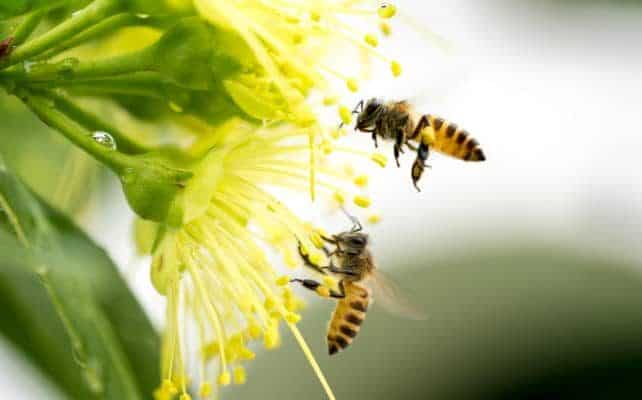If you think about how bees fly miles and miles on daily basis to extract nectar, it comes only natural to wonder how many wings do these buzzing creatures have? Is it not amazing how fast they can flap their wings?
Just like other winged Hymenopterans, bees have four wings and can flap their wings at an average speed of 230 beats within a second. This ability enables bees to carry almost their body weight in pollen and nectar. They also fast with a top speed of 15 MPH.

How do bees benefit from this speed? How do the wings enable the bees to carry heavy loads? How does their speed compare to that of other insects?
Read on to find the answer to these questions and learn more about our bumbling friends
The Speed and Action of Bees’ Wings
Initially, scientists assumed that the bees’ wings were rigid, meaning that they would fly by moving their wings up and down. However, considering the size of a bee, it would be impossible for their rigid wings to beat at a speed of 230 beats per second.
Scientists have spent many years “scratching their head” trying to understand how bees would fly at such a high speed. After detailed research, they discovered that bees’ wings are not rigid. Instead, they move and rotate as they fly. During flights, bees make short, swift motions to and fro repeatedly.
Bees’ movement is driven by muscles located on the thorax, commonly referred to as Dorsoventral Muscles (DVMs) and the Dorsal-longitudinal Muscles (DLM). Whenever the DLM contracts, the body of the insect is forced to move front-to-back while the wings automatically move downwards.
On the other hand, whenever the DVMS contracts, the bee body is forced to move top-to-bottom, and the wings spontaneously flap upwards.
The stretch activation feature guides the muscles. Subsequently, they are activated when stretched to a certain degree. The two muscles are antagonistic. Therefore, they function in opposite directions-whenever one is stretched, the other one contracts.
How the Wings Enables the Bees to Carry Heavy Loads
It may come as a surprise but bees are among the biggest load lifters insect in the world. Considering their small size, someone cannot help but wonder how research has proved that bees can carry loads equivalent to 80% of their body weight with the help of their wings.
An investigation carried out by Sciencedaily on bumblebees discovered that they use two flight modes to enable easy transportation. They choose which mode to use when flying, depending on what they are carrying or what they are doing.
When they are carrying heavy loads, bees switch to a different mode by changing their wings frequency which enables them to produce enough energy to support the heavy load. Increasing their stroke amplitude intensifies the energetic cost by generating higher lifts.
On the flip side, when the bees are resting or carrying light loads, they beat their wings on a high frequency as they don’t need much energy.
We have a whole article on “How bees fly” with some super slow-motion video if you are interested in exploring this further.
A Comparison of the Speed of Bees and Other Insects
In the table below you can check, and analyze the speed of bees comparing to other common insects.
| Insect | Speed |
| Honey Bee | 15 MPH |
| Fly | 5 MPH |
| Butterfly | 12 MPH |
| Wasp | 7 MPH |
| Mosquito | 1.5 MPH |
| Praying Mantis | 1.5 MPH |
As you can see, bees have the fastest speed compared to the other insects.
How do Bees Fly?
Before you realize there is a bee on top of your head and start freaking out, you are likely to hear the buzzing sound first. One of the common mysteries for many is how bees fly while making a buzzing sound. Well, the buzzing sound usually happens as a result of the frequent beating of the bees’ wings. The ability of bees to fly is a result of the following elements.
- Wing frequency
- Wing rotation
- Wing amplitude
Bees have a pair of wings on either side of the body. The outer pair is larger than the inner one. These wings are held together by hamuli, which are comb-like teeth. The teeth enable the bee wings to act like a single large surface that lifts the bee enabling it to fly.

How Many Times Does a Bee Flap its Wings Per Minute?
Considering that bees are the fastest insect in terms of speed, one obvious question is how fast they can flap the wings within a single minute. In 1947, a scientist discovered that bees could flap their wings at a rate between 108 and 211 beats in a second.
In case we convert seconds to minutes, we will conclude that bees can flap their wings at a range of 12,480 and 16,830 beats within a minute.
This is a tremendous speed. Research in 1973 concluded that when a bee is flying without carrying pollen or nectar, it can fly at approximately 7.5 meters within a second. Consequently, a bee can fly up to 300 meters in a minute or less. This is likely to happen when the bee is flying in a straight line, and the weather is calm.
What are Bee Wings Made of?
Bee wings are made of chitin, a material similar to the keratin found in human fingernails. The wings include a pair of hindwings and forewings. Hindwings typically tuck underneath the forewings when the bee is not in flight mode.
Bees’ wings are usually transparent, and one can easily see through them. Nevertheless, this does not mean they are weak. Don’t forget they can carry a load of pollen or nectar that is almost equal to their body weight.
The wings also have hemolymph, which functions as insect blood. Additionally, they have nerves and air tubes that make the wings more stable and strong. Different types of bees have unique vein patterns on their wings. The wings are further connected to the bee muscles on the thorax.
Bee wings can propel, helping the insect fly in different directions. As bees develop through the metamorphosis process, the wings are the last body section to be formed.
Wings are among the essential parts of bees since it’s their mode of transportation from one place to another. Researchers have approximated that bees can travel 500 miles before their wings get weary and start to tear.

How High Can Bees Fly?
Bees are classified among the most active insects because they are always flying, looking for pollen to transfer nectar. This is good since bees contribute to pollination, which further facilitates the production of farming products. Conversely, one is likely to wonder how far can these insects fly and what controls their ability to fly.
Scientists based at the University of California found out that bumblebees are not inhibited by their flying capacities when in search of new colonies.
In most cases, their decision is controlled by the availability of flower nectar. As they were conducting the research, they also discovered that the bees are quite the “mountainers” as they are able to fly higher than Mount Everest.
However, they cannot survive at the peak of the mountain because it is naturally freezing. High elevations and low oxygen levels can only limit bumblebees’ flight capacity.
